| |
| |
Photographer,
Location |
Images |
Comments |
|

|
Peter
McCabe,
Dundalk, Co. Louth, Ireland
Aug. 7, 2009 |
#1 |
I
set up my camera last night hoping to get a few Perseids.
This one shot across the sky behind my back. I didn't see
it, but the camera did!
Photo
details: Canon
450D, 20mm wide angle lens, 25 seconds |
|
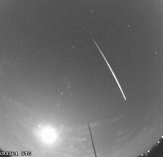
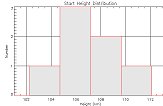
|
Bill
Cooke,
NASA Meteoroid Environment Office, Huntsville, Alabama
Aug. 4, 2009 |
#1,
#2,
#3 |
Using a pair of all-sky
cameras, NASA astronomer Bill Cooke photographed this
Perseid skimming the top of Earth's atmosphere on August
4th. Because the Earthgrazer was captured on two cameras
100 miles apart, he was able to triangulate its position
and measure its velocity. "It came in at 58.8 km/s
and disintegrated between 111 and 86 km above Earth's surface,"
he says. So far, the dual-camera system has captured seven
bright Perseids suitable for analysis. Cooke's histograms
of starting
and ending
heights answer the question, how high is a Perseid? |
|
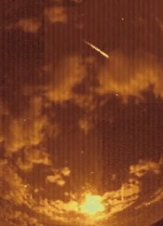
[movie+sounds]
|
Thomas
Ashcraft ,
near Santa Fe, New Mexico
Aug. 4, 2009 |
#1,
#2,
more |
On August 4th, amateur astronomer
Thomas Ashcraft caught an early Perseid using an all-sky
camera at his observatory near Santa Fe, New Mexico. Click
here play a movie with sound effects. The "ping"
you just heard was a 61.25 MHz TV signal bouncing off the
meteor's ionized tail. Ashcraft keeps an antenna trained
on the sky so that he can record the echos and lay them
down as soundtracks for his all-sky movies. |
|
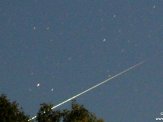
|
Brian
Emfinger,
Ozark, Arkansas, US
Aug. 1, 2009 |
#1,
#2,
#3,
more |
The
Perseids continue to slowly increase. I caught 4 meteors
with two nice ones. This fireball was battling fading sunlight
and the moon yet still is easily visible! The second one
is from early morning and has very nice color and clearly
shows the Perseid Radiant.
Photo
details: Canon
Digital Rebel XT, ISO 1600, F3.5, 30secs |
|
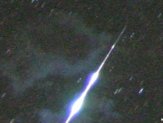
|
Brian
Emfinger,
Ozark, Arkansas, USA
Jul. 26, 2009 |
#1,
#2,
more |
I
caught this bright Perseid Fireball with smoke trail just
after midnight on Sunday July 26th.
Photo
details: Canon
Digital Rebel XT, ISO 1600, F3.5, 1 min exposure. |
more
images: from
Banafsheh Golabgiran of Firuzkuh, Tehran, Iran; from
Robin Geys of Kapellen, Belgium; from
Bob Johnson of Saskatoon, Saskatchewan; from
Paul Evans of Larne, Northern Ireland; from
Monika Landy-Gyebnar of Veszprem, Hungary;
|
|